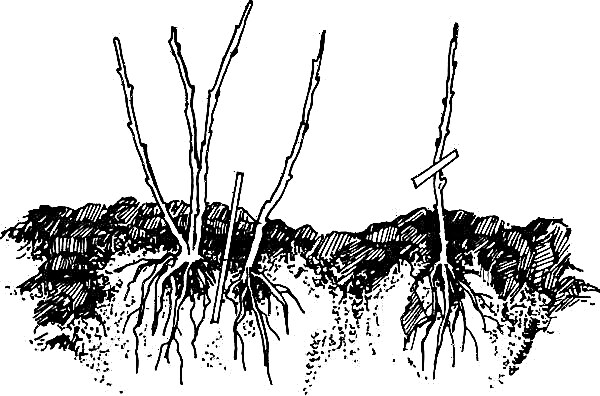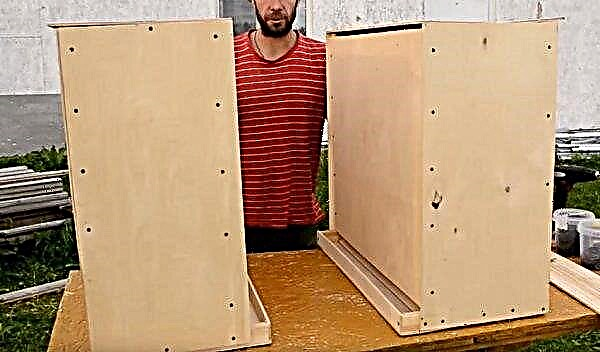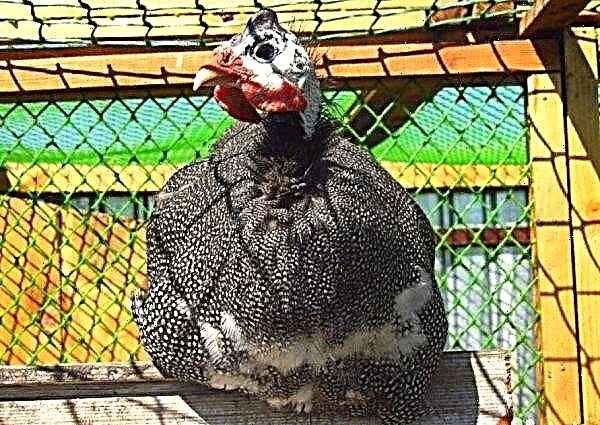Violets are one of the most sought-after plants in indoor crop production, so it is not surprising that almost every grower has a variety in his collection. Choosing a suitable option for yourself, you should focus not only on the beauty of the flowers, but also on the ease of care for them, because only with the correct execution of all actions you can achieve excellent flowering of the plant. This also applies to the variety Le Rosemary, the nuances of the cultivation of which will be discussed in this article.
Botanical description of the plant
Compared to other violets, the flowers of this plant form unusual lush pompons with a diameter of about 6 cm. Moreover, at least 2-3 such flowers are on one peduncle, which means that the brush will be even more voluminous and more attractive. Each terry flower consists of wavy petals, sometimes with an interesting pattern in the form of spots, strokes or dots.
All Le Rosemary violet flowers are complemented by short peduncles, thanks to which the bouquets are collected in the center of the outlet itself. Usually they are characterized by pink bloom, with a yellow middle of flowers and white edges of the petals, however, purple varieties are often found. In any case, these flowers look great against the background of the dark green leafy plates of the plant, which, by the way, also have a wavy edge.
Photo gallery
With good care, the blooming of violets is year-round, however, in order to achieve this, it is necessary to create the most optimal conditions for the plant to grow and develop.Did you know? For the first time, violets were talked about in large numbers in 1893, when they began to be displayed at a flower exhibition and were described in the Gartenflora magazine. This year was considered the year of their birth.
Conditions for successful growing at home
In order for violets to always please with lush and plentiful flowering, in addition to properly organized care, they will also need a suitable placement with optimal indicators of temperature, humidity and lighting level. Each variety differs in its requirements in this matter, so we suggest that you familiarize yourself with the main criteria for the content of Le Rosemary violets.
Location and Lighting
The described plant belongs to photophilous violets, but, like many other varieties of a flower, it does not tolerate direct sunlight. An ideal place to place a pot is window sills from the western or eastern part of the house, where only scattered sun rays fall during the day. With the advent of colds and a decrease in the duration of daylight hours, flowers will have to be installed above the flowers, which will extend the flowering of violets for almost the entire winter period.
With the advent of colds and a decrease in the duration of daylight hours, flowers will have to be installed above the flowers, which will extend the flowering of violets for almost the entire winter period.
Important! The violet Le Rosemary will inform the florist about the lack of lighting by raising the leaves and losing the general decorative effect, and moving the flower pot to a more illuminated place will help to correct the situation.
Temperature and humidity
Almost all violets are heat-loving plants, for which lower temperatures are fraught with decay of the root system and a shortening of the flowering period. This also applies to the variety Le Rosemary, whose flowers prefer values between + 20 ... + 23 ° C with a relative humidity of not more than 60%.
In the cold season, when the room temperature drops, it is better to remove the pots from the window sills, transferring them to racks or special flower stands located in the central part of the room. However, sharp temperature changes are detrimental to violets and often lead to the development of diseases (for example, all kinds of rot) or stop flowering, which means that you need to make every effort to avoid such fluctuations.
Home Care
The basic requirements for caring for indoor flowers are the same when growing any plants and provide for timely watering, top dressing, pruning, and sometimes transplanting. Violet belongs to the decorative-flowering plants, therefore, to ensure its high decorativeness, it is advisable to consider the following recommendations.
Watering
The introduction of fluid into the soil should be moderate and should be performed no more than 2-3 times a week. Excessive watering threatens the decay of the root of Le Rosemary and the death of the whole plant. The water used must always be warm enough (not lower than + 20 ... + 22 ° C), well-settled, and if possible filtered. Melted liquid is also suitable, but collecting it is not always possible.
As for the method of watering the flower, then both options are suitable: upper and lower. In the first case, water should be poured along the edge of the pot, trying not to get on the leaves or the stem part of the violet (the soil should evenly absorb moisture throughout the entire diameter of the container).  In the second, liquid is poured into the pan of the pot so that the roots of the plant themselves absorb as much moisture as they need. It is this option that is considered more correct for uniform soil moisture and protect the outlet growth point from excess moisture.
In the second, liquid is poured into the pan of the pot so that the roots of the plant themselves absorb as much moisture as they need. It is this option that is considered more correct for uniform soil moisture and protect the outlet growth point from excess moisture.
Top dressing
It is advisable to feed Le Rosemary violets throughout the year. Before flowering begins (usually in January-February), the green mass of the plant is increased using nitrogen-containing compounds (for example, “Stimovit” or “Master Color”), and during the bud formation period they are replaced with phosphorus-potassium compounds, which contribute to the abundant and prolonged flowering of room violet . In the latter case, Kemira Lux fertilizer is often used, with a frequency of 1 time in 2 weeks.
Like other varieties of violets, Le Rosemary tolerates both root and foliar top dressing by spraying the leaves equally well. However, in the latter case, it will be necessary to pay special attention to the absence of drafts and direct sunlight, so that the pubescent leaves do not retain moisture. The solution for processing in this way should be two times weaker than with the root method. Fertilization through the leaves is desirable to perform in cloudy weather and only after preliminary cleaning of the sheet plate from dirt and dust.Important! To increase the efficiency of feeding, the selected composition can be applied to the soil weekly, dividing the recommended dose on the package by 2 times.

Pruning
Formative pruning of the described violet is not needed, but for sanitary purposes you still have to remove faded peduncles, damaged and yellowed leaves. The outlet itself can also be cut off (only a small stump-leg is left under the lower leaves). If you lower its lower part into the water, then soon new roots will grow on it and it will be possible to renew the plant.
For the uniform development of the rosette, it is advisable to periodically turn the pot with the plant to the light in different directions, then all the leaves will be the same color and size.
How to transplant
Variety Le Rosemary does not need a volumetric pot, because excess space can be one of the reasons for the late flowering of the plant. A good option for placement would be plastic containers with drainage holes at the bottom and a diameter 2 times smaller than the violet outlet. As soon as the soil is completely filled with roots, the plant will begin to produce peduncles.
When buying an already flowering specimen, you can not transplant it, at least until the roots appear from the drainage holes. In addition, the cause of this action will also be rotting of the root system, waterlogging of the soil and depletion of nutrient reserves of the substrate. In the latter case, the signal for transplantation will be the appearance of a white coating on the soil surface and the entanglement of an earthen coma with the root system of the plant (to verify this, it is enough to remove the violet from the pot). Regardless of the reason, the procedure can be performed all year round, with the exception of the winter months and the budding period.
In the latter case, the signal for transplantation will be the appearance of a white coating on the soil surface and the entanglement of an earthen coma with the root system of the plant (to verify this, it is enough to remove the violet from the pot). Regardless of the reason, the procedure can be performed all year round, with the exception of the winter months and the budding period.
The new soil mixture must be nutritious and at the same time sufficiently loose, for which one part of river sand, three parts of peat and five parts of deciduous soil are usually mixed. If these ingredients are not available, then you can always buy a ready-made substrate in any flower shop, and calcine it in the oven before planting.
The transplant process is simple, but consists of several important steps:
- To get started, prepare a new pot, pour a drainage layer of pebbles, small stones or chipped bricks (no more than 2 cm high) into it and fill it with prepared nutrient mixture to half, pre-adding 1 tbsp. spoon of superphosphate and wood ash.
- Remove the transplanted plant from the old pot and place it in the center of the new one, carefully sprinkling it with soil so that at least 1 cm of free space remains to the edge of the planting capacity.
- Pour the violet and place the pot in a warm place with adequate lighting.
 With further care, the violet needs to create the most comfortable conditions, because a transplant is always a stress for the plant, the consequences of which can be noticed within the first month after the procedure (for example, when exposed to drafts, leaf withers and flower petals fall).
With further care, the violet needs to create the most comfortable conditions, because a transplant is always a stress for the plant, the consequences of which can be noticed within the first month after the procedure (for example, when exposed to drafts, leaf withers and flower petals fall).
Did you know? The name "Rosemary" is of Latin origin and translates as "dew of the sea" or "fog on the sea." Some flower growers also suggest that this word was formed by a combination of two female names - Rose and Mary.
How to propagate at home
Any violets can be propagated in several ways: seeds and cuttings, the role of which is ideal for plant leaves. However, the seed method is more time-consuming, besides it does not always lead to the desired result, which is why the Le Rosemary variety is recommended to be grown by rooting the leaves. This process involves the following actions:
- Cut a large and healthy leaf on a short cut from the mother plant (a very elongated cut will not work here, as it may not give children). The cut should be done with a sharp, sanitized knife, at an angle of 45 °.
- Place the resulting material in a small container (for example, in a glass with a diameter of 5-6 cm) with a drainage layer and a prepared substrate (it is useful to add a pinch of wood ash and the same amount of superphosphate to the finished mixture).
- Deepen the cut sheet into the soil by 2-10 cm, moisten the soil from the spray gun and cover it with a transparent cap.
 After the successful rooting of such a stem, a young plant can be planted in a permanent pot, observing the rules of planting.
After the successful rooting of such a stem, a young plant can be planted in a permanent pot, observing the rules of planting.Growing difficulties
Almost all flower growers sooner or later encounter certain difficulties when growing decorative-flowering plants. Violet Le Rosemary can also cause its owners some trouble, but for the most part they are all associated with violations of flower care requirements. The most common problems include:
- Lack of flowering. Check the lighting level (daylight hours must be at least 12 hours) and the volume of the pot (it should not be too spacious).
- Darkening and falling of leaf plates. Perhaps the leaves come in contact with a cold window, when watering, water (especially cold) gets on them or direct sunlight. Recheck the relevance of Le Rosemary violet cultivation conditions.
- Bending the edges of the leaf plates of a flower. Most often, this phenomenon is due to planting in acidic soil, and it is better to transplant the plant as soon as possible.
- Yellowing of the leaves and the appearance of a yellow border on them. It is likely that the flower lacks nutrients, so it is better to revise the feeding schedule or transplant the violet into a more nutritious substrate.
- Incomplete disclosure of flowers and their quick drying. Perhaps the room has a high temperature and increased air dryness, and the plant itself is planted in a pot with acidic soil. Try transplanting violet into neutral and loose soil.
- Leaves hanging from a pot. The main reason is too bright sunlight and increased air dryness. As soon as you make the lighting more diffuse and increase the humidity in the room, everything should return to normal.
 If the first signs of their development are detected, it is advisable to transplant the violet into another pot, having previously removed all damaged parts. To reinsure yourself, you can additionally spray the transplanted flower with one of the fungicides, for example, “Fundazole” or a solution of copper sulfate.
If the first signs of their development are detected, it is advisable to transplant the violet into another pot, having previously removed all damaged parts. To reinsure yourself, you can additionally spray the transplanted flower with one of the fungicides, for example, “Fundazole” or a solution of copper sulfate.Of the pests, the violet is threatened by thrips, scabs and ticks, the appearance of which is also accompanied by the formation of small spots, holes, cobwebs and sticky plaque on the leaves. Insecticides - Agravertin, Aktara or Actellik will help remove them from the plant.
In general, caring for Le Rosemary violet is no more difficult than caring for other varieties of this plant, and all that is required of the flower grower is to adhere to the above recommendations regarding flower placement, watering, dressing and transplanting. If you look, then none of these actions will be too difficult for both an experienced and a beginner grower.












